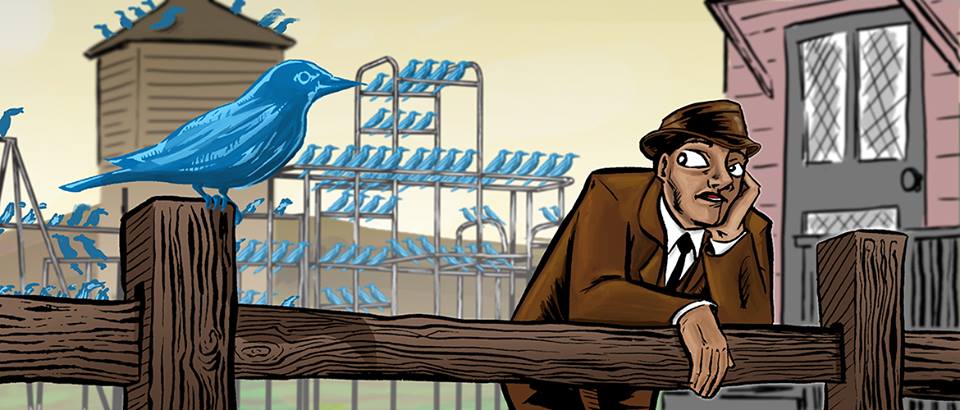People often sell products and services better than websites do. That’s why automated systems don’t do telesales and why door-to-door salesmen can still make a living (once you let them in). It’s also why video marketing is successful.
Transacting with a real human not only reduces the chances of rejection, but it also induces the fuzzy feeling we get when we talk to new, interesting strangers.
Would you like to be a new, interesting stranger? You do if you have a product or service to sell. After that stage, you want to be a loyal friend who always has the best answers and is willing to bend over backward to make their friends happy.
Customer service is an art form that local mom and pop shops and independent small business have perfected.
Here are a few ways that you can start humanizing your business today, right now, right this minute. Some of them are through social media and blogging, others are through basic human connection.

- Say THANK YOU and MEAN IT: Possibly most important, being humble is a marvelous trait of local businesses, and this translates even more wonderfully online, because it’s such an impersonal medium. I still remember the time Wistia sent Patrick a t-shirt because he kept shouting them out on Twitter, and the time FreshPet sent us a giant cooler of dog food, treats, and swag because we wrote a nice blog post about them. How about when Gary Vaynerchuk sent a box of swag for buying his book? Heck, I blushed when J.C. Cellars sent me a Christmas card. Loyal customers for life? Yes, indeed.
- Be in front of your customers: Your name and persona as a brand can be even more powerful than the name of your business. Food artisans and farmers use Farmer’s Markets to launch new products and build face-to-face relationships with their community. Tech companies do the same by holding Tweetups and conferences that let them mingle with customers and one-day-I’ll-get-ya customers.
- Start answering the phone: Don’t let any call go to voicemail when you’re available to pick up. Don’t direct people to email when they want to talk. Some people prefer a real conversation. Besides, emails can be impersonal (helloooo autoresponders) and often your tone doesn’t translate well and can lead to a communication breakdown. If your customer sounds chatty, don’t end the call too briefly, keep talking. One time a customer service rep asked me to give him a call after I sent him a Tweet. From there we actually chatted about social media marketing for about an hour. Now I promote their business at every publishing conference I speak at because there’s a loyalty that was established in that hour.
- Eliminate any generic scripts you’ve been working on: Even the most profitable chain restaurants are honoring their guests by humanizing their sales pitches. “Chain restaurants like Denny’s, T.G.I. Friday’s, and Romano’s Macaroni Grill are focusing more on personalized service by training staff to note body language, eye contact, and offhand remarks, hoping to make service feel less mechanical,” says The Wall Street Journal.
- Make your customers feel smart: Loyal customers are planted and grown; they’re not just in bloom the moment they walk into your store. Part of being an extraordinary business owner is the ability to connect with your customers in such a way that each one feels like they left with more than they walked in with. Accomplish this by educating customers through your interactions, which can be easily attained in any type of business.
- Connect a blog to your business and get comfortable: The tune of your business can be defined by the likeable voice of your blog and editorial storytelling. Straight and to the point is great when you’re on a fact-finding mission, but even white-collar posts about things like analytics are digested more easily, and are taken with more than a grain of salt when provided with a backstory.
- Take it to the streets by considering a pop-up shop: Flash retailing involves opening a short-term store that sort of “pops up” until the merchandise is sold. Think of your pop-up shop as an event; a transportable liquidation or bakesale. It can be as simple as setting up a table at a farmer’s market, at your local Flea, or even right in front of your store.
- Get interviews with local media outlets: For a small business, this might sound difficult, but it’s not. News outlets and local blogs always need something to write about, and once you make yourself accessible to them, you’ll have plenty of opportunities. Not only as a brand ambassador, but also as a subject-matter expert, you’re a wealth of knowledge with your own perspective and stories to share.
- Ask for feedback and implement it quickly: Comment cards aren’t a thing of the past, just a little outdated. Just look at Houlihan’s, who launched a social network meant only for their customers, “an invite-only ‘brand community’ of 10,500 ‘Houlifans’ to serve as a virtual comment card,”according to Fast Company. Since launching the community, which traded recipes for genuine feedback, sales are up 12%.
- Take your social media fans offline: The one-to-many concept works great for online businesses, but local businesses take the extra steps to get those digital footprints onto their physical doormats. Digital companies can replace a storefront by hosting parties and sponsoring events, while local businesses work on taking better photos, inviting customers in for private sales, and hosting workshops.
Got it? Good. Now you have some work to do. And if you’re feeling like you have too much else on your plate, just hire us to handle getting new leads sent your way through great blog content.





